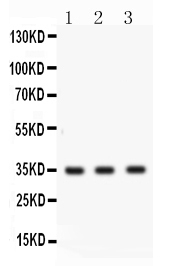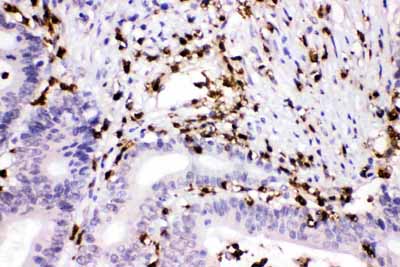Anti-Cathepsin G Picoband Antibody
- SPECIFICATION
- CITATIONS
- PROTOCOLS
- BACKGROUND

Application
| WB, IHC-P |
|---|---|
| Primary Accession | P08311 |
| Host | Rabbit |
| Reactivity | Human |
| Clonality | Polyclonal |
| Format | Lyophilized |
| Description | Rabbit IgG polyclonal antibody for Cathepsin G(CTSG) detection. Tested with WB, IHC-P in Human. |
| Reconstitution | Add 0.2ml of distilled water will yield a concentration of 500ug/ml. |
| Gene ID | 1511 |
|---|---|
| Other Names | Cathepsin G, CG, 3.4.21.20, CTSG |
| Calculated MW | 28837 MW KDa |
| Application Details | Immunohistochemistry(Paraffin-embedded Section), 0.5-1 µg/ml, Human, By Heat Western blot, 0.1-0.5 µg/ml, Human |
| Subcellular Localization | Cell surface . |
| Protein Name | Cathepsin G |
| Contents | Each vial contains 5mg BSA, 0.9mg NaCl, 0.2mg Na2HPO4, 0.05mg NaN3. |
| Immunogen | E. coli-derived human Cathepsin G recombinant protein (Position: R25-E252). Human Cathepsin G shares 69.7% amino acid (aa) sequence identity with mouse Cathepsin G. |
| Purification | Immunogen affinity purified. |
| Cross Reactivity | No cross reactivity with other proteins |
| Storage | At -20˚C for one year. After r˚Constitution, at 4˚C for one month. It˚Can also be aliquotted and stored frozen at -20˚C for a longer time.Avoid repeated freezing and thawing. |
| Name | CTSG |
|---|---|
| Function | Serine protease with trypsin- and chymotrypsin-like specificity (PubMed:8194606, PubMed:29652924). Also displays antibacterial activity against Gram-negative and Gram-positive bacteria independent of its protease activity (PubMed:2116408, PubMed:2117044). Prefers Phe and Tyr residues in the P1 position of substrates but also cleaves efficiently after Trp and Leu (PubMed:29652924). Shows a preference for negatively charged amino acids in the P2' position and for aliphatic amino acids both upstream and downstream of the cleavage site (PubMed:29652924). Required for recruitment and activation of platelets which is mediated by the F2RL3/PAR4 platelet receptor (PubMed:3390156, PubMed:10702240). Binds reversibly to and stimulates B cells and CD4(+) and CD8(+) T cells (PubMed:7842483, PubMed:9000539). Also binds reversibly to natural killer (NK) cells and enhances NK cell cytotoxicity through its protease activity (PubMed:9000539, PubMed:9536127). Cleaves complement C3 (PubMed:1861080). Cleaves vimentin (By similarity). Cleaves thrombin receptor F2R/PAR1 and acts as either an agonist or an inhibitor, depending on the F2R cleavage site (PubMed:10702240, PubMed:7744748). Cleavage of F2R at '41-Arg-|- Ser-42' results in receptor activation while cleavage at '55-Phe-|-Trp- 56' results in inhibition of receptor activation (PubMed:7744748). Cleaves the synovial mucin-type protein PRG4/lubricin (PubMed:32144329). Cleaves and activates IL36G which promotes expression of chemokines CXCL1 and CXLC8 in keratinocytes (PubMed:30804664). Cleaves IL33 into mature forms which have greater activity than the unprocessed form (PubMed:22307629). Cleaves coagulation factor F8 to produce a partially activated form (PubMed:18217133). Also cleaves and activates coagulation factor F10 (PubMed:8920993). Cleaves leukocyte cell surface protein SPN/CD43 to releases its extracellular domain and trigger its intramembrane proteolysis by gamma-secretase, releasing the CD43 cytoplasmic tail chain (CD43-ct) which translocates to the nucleus (PubMed:18586676). Cleaves CCL5/RANTES to produce RANTES(4-68) lacking the N-terminal three amino acids which exhibits reduced chemotactic and antiviral activities (PubMed:16963625). During apoptosis, cleaves SMARCA2/BRM to produce a 160 kDa cleavage product which localizes to the cytosol (PubMed:11259672). Cleaves myelin basic protein MBP in B cell lysosomes at '224-Phe-|-Lys-225' and '248-Phe-|-Ser-249', degrading the major immunogenic MBP epitope and preventing the activation of MBP-specific autoreactive T cells (PubMed:15100291). Cleaves annexin ANXA1 and antimicrobial peptide CAMP to produce peptides which act on neutrophil N-formyl peptide receptors to enhance the release of CXCL2 (PubMed:22879591). Acts as a ligand for the N-formyl peptide receptor FPR1, enhancing phagocyte chemotaxis (PubMed:15210802). Has antibacterial activity against the Gram-negative bacteria N.gonorrhoeae and P.aeruginosa (PubMed:2116408, PubMed:1937776). Likely to act against N.gonorrhoeae by interacting with N.gonorrhoeae penA/PBP2 (PubMed:2126324). Exhibits potent antimicrobial activity against the Gram-positive bacterium L.monocytogenes (PubMed:2117044). Has antibacterial activity against the Gram-positive bacterium S.aureus and degrades S.aureus biofilms, allowing polymorphonuclear leukocytes to penetrate the biofilm and phagocytose bacteria (PubMed:2117044, PubMed:32995850). Has antibacterial activity against M.tuberculosis (PubMed:15385470). Mediates CASP4 activation induced by the Td92 surface protein of the periodontal pathogen T.denticola, causing production and secretion of IL1A and leading to pyroptosis of gingival fibroblasts (PubMed:29077095). |
| Cellular Location | Cell membrane; Peripheral membrane protein. Cytoplasmic granule. Secreted. Cytoplasm, cytosol. Lysosome. Nucleus. Note=Secreted by activated neutrophils (PubMed:3390156). Detected in synovial fluid (PubMed:32144329) Localizes to lysosomes in B cells where it is not endogenously synthesized but is internalized from the cell membrane (PubMed:15100291). Localizes to the nucleus during apoptosis (PubMed:11259672). |
| Tissue Location | Expressed in neutrophils (at protein level) (PubMed:3799965). Expressed in B cells (PubMed:15100291) |

Thousands of laboratories across the world have published research that depended on the performance of antibodies from Abcepta to advance their research. Check out links to articles that cite our products in major peer-reviewed journals, organized by research category.
info@abcepta.com, and receive a free "I Love Antibodies" mug.
Provided below are standard protocols that you may find useful for product applications.
Background
Cathepsin G is an enzymatic protein belonging to the peptidase or protease families. In humans, it is coded by the CTSG gene. This gene is mapped to 14q12. In transgenic mice, it was found that human Cathepsin G gene was expressed in early myeloid precursors in a manner coordinate with the expression of the endogenous murine gene in the bone marrow and spleen. The protein encoded by this gene, a member of the peptidase S1 protein family, is found in azurophil granules of neutrophilic polymorphonuclear leukocytes. The encoded protease has a specificity similar to that of chymotrypsin C, and may participate in the killing and digestion of engulfed pathogens, and in connective tissue remodeling at sites of inflammation.
If you have used an Abcepta product and would like to share how it has performed, please click on the "Submit Review" button and provide the requested information. Our staff will examine and post your review and contact you if needed.
If you have any additional inquiries please email technical services at tech@abcepta.com.













 Foundational characteristics of cancer include proliferation, angiogenesis, migration, evasion of apoptosis, and cellular immortality. Find key markers for these cellular processes and antibodies to detect them.
Foundational characteristics of cancer include proliferation, angiogenesis, migration, evasion of apoptosis, and cellular immortality. Find key markers for these cellular processes and antibodies to detect them. The SUMOplot™ Analysis Program predicts and scores sumoylation sites in your protein. SUMOylation is a post-translational modification involved in various cellular processes, such as nuclear-cytosolic transport, transcriptional regulation, apoptosis, protein stability, response to stress, and progression through the cell cycle.
The SUMOplot™ Analysis Program predicts and scores sumoylation sites in your protein. SUMOylation is a post-translational modification involved in various cellular processes, such as nuclear-cytosolic transport, transcriptional regulation, apoptosis, protein stability, response to stress, and progression through the cell cycle. The Autophagy Receptor Motif Plotter predicts and scores autophagy receptor binding sites in your protein. Identifying proteins connected to this pathway is critical to understanding the role of autophagy in physiological as well as pathological processes such as development, differentiation, neurodegenerative diseases, stress, infection, and cancer.
The Autophagy Receptor Motif Plotter predicts and scores autophagy receptor binding sites in your protein. Identifying proteins connected to this pathway is critical to understanding the role of autophagy in physiological as well as pathological processes such as development, differentiation, neurodegenerative diseases, stress, infection, and cancer.



